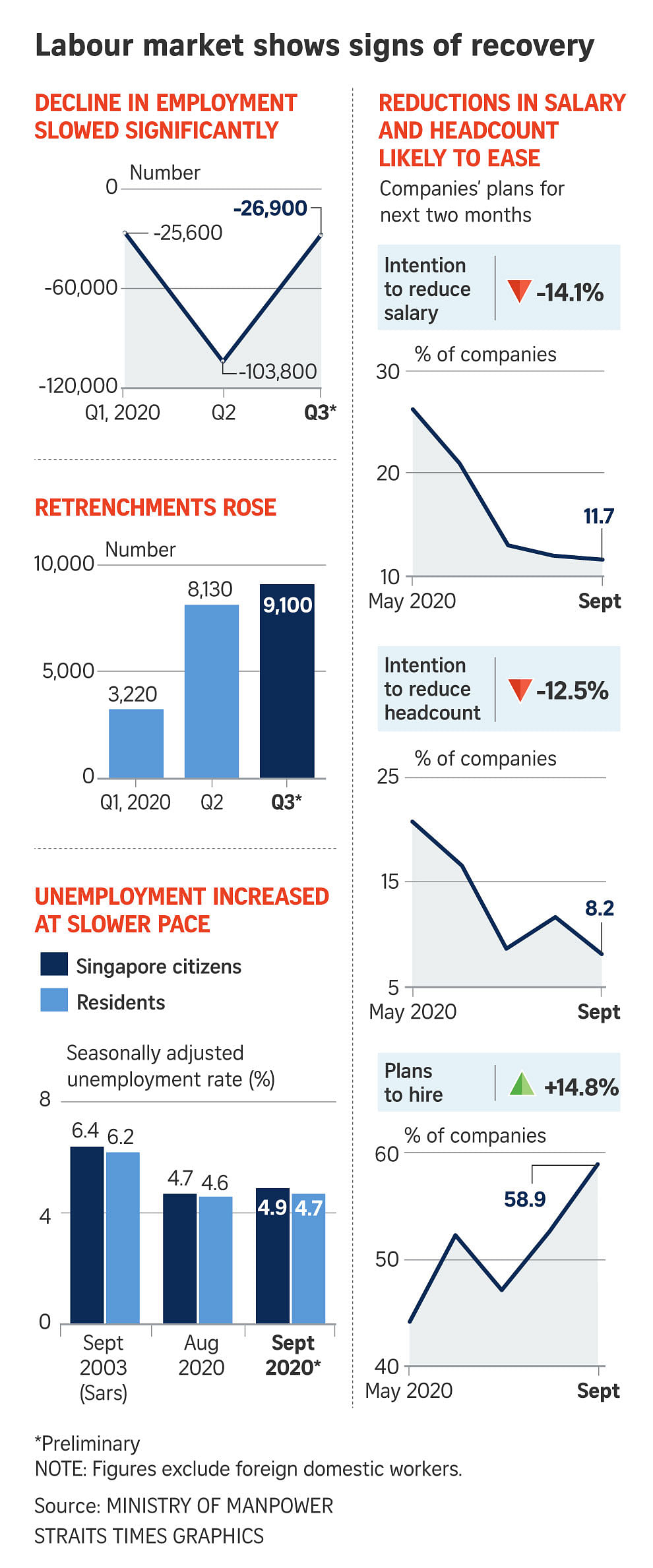SINGAPORE - The number of employed locals rebounded to almost pre-Covid-19 levels in the period between July and September, but the labour market is not out of the woods yet, with retrenchments and overall unemployment continuing to rise.
Around 2.34 million Singaporeans and permanent residents were employed in September, recovering strongly from the 2.29 million seen in June, preliminary data released by the Ministry of Manpower (MOM) showed on Friday (Oct 30).
This was almost on a par with resident employment levels before the coronavirus pandemic - about 2.36 million locals were employed in December 2019.
Speaking to reporters on Friday, Manpower Minister Josephine Teo was cautious about the prospects for the job market, even though she said the third quarter figures were "a bit of a relief".
"I think it would not be wise to take it as a given that (this rebound) will be sustained," she said.
"The ship has stabilised, but we need to put in the effort to keep sailing towards the destination... which is to sustain local employment to where it was previously. That's something that we should have to work very hard towards."
Dip in total employment
Despite the rebound in local employment, total employment, excluding foreign domestic workers, continued to decline in the period between July and September.
Some 26,900 workers were shed, largely due to the continued decline in non-resident employment, the ministry said.
The sharpest cuts were seen in the construction and manufacturing sectors, where non-residents were laid off.
But an increase in hiring was seen among the services sector, in segments such as food and beverage services and healthcare.
Mrs Teo noted that the contraction in non-local employment was due to two main reasons: the repatriation of some foreign employees as well as the lower inflow of foreign workers into Singapore due to tightening of employment pass policies.
These factors also contributed to the rise in local employment, she said, in addition to collective efforts by both employers and workers to retain jobs.
Another reason for the rise in resident employment was due to the resumption of work activities and backfilling of positions which were vacated in the April to June period, she added.
In addition, job-matching efforts contributed to greater awareness and opportunities for job seekers, boosting resident employment, Mrs Teo said.
Unemployment rate for locals up
Meanwhile, the unemployment rate for locals - Singaporeans and permanent residents - rose to 4.7 per cent in September, slightly worse than the 4.6 per cent seen in August.
There were 112,500 unemployed residents in September, of whom 97,700 were Singaporeans.
Explaining why both the number of employed locals and the resident unemployment rate went up in the third quarter, Mrs Teo said that this is because while more locals are getting jobs, the pool of job seekers has also grown.
But there is a positive takeaway from this, she said. "It means that people are joining the search, but also that people are getting the work.
"Now of course, the aim must be to shrink the unemployed pool, we want the number to go down, and we want to bring up the employed numbers."
Retrenchments also rose
Retrenchments rose further in the third quarter to 9,100, compared with 8,130 in the previous three-month period. This is higher than retrenchment numbers in the peak of previous recessions, except for the first quarter of 2009 during the global financial crisis.
A total of 12,760 jobs were shed that quarter.

Layoffs are expected to increase in the manufacturing and services sectors, and primarily in the air transport as well as arts, entertainment and recreation industries for the third quarter.
This is because these sectors continued to be affected by the coronavirus pandemic and the need for safe management measures, MOM said.
Meanwhile, the construction sector is likely to see a decline in retrenchments with the gradual resumption of activities following the circuit breaker period.
The ministry said that weakness in the labour market is likely to persist, as companies and workers continue to operate in an uncertain economic environment, and the conditions for travel-related sectors are expected to remain challenging.
In its report, MOM noted that salary and headcount reductions could subside in the months ahead as business sentiments and economic conditions improve.
The proportion of companies polled in September which indicated intentions to cut salaries or headcount has been on a downtrend since May. At the same time, more companies plan to hire in September compared to previous months.


